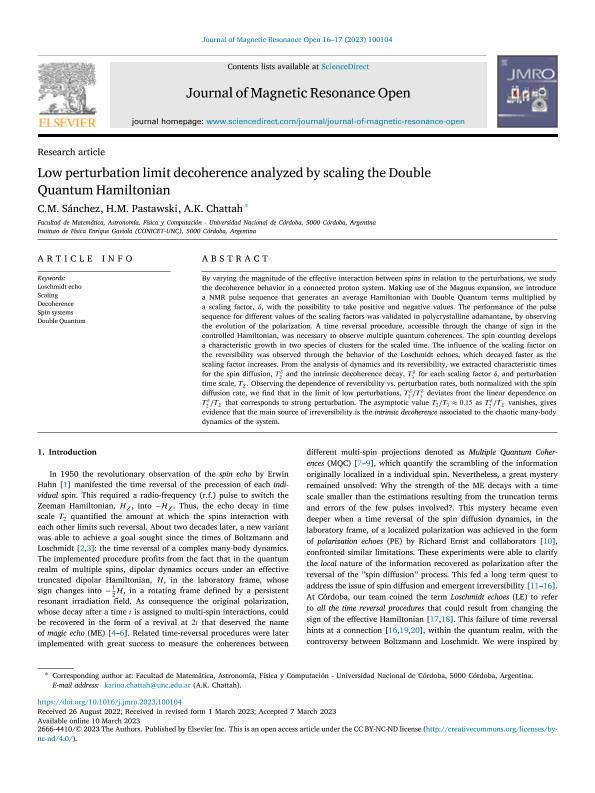Mostrar el registro sencillo del ítem
dc.contributor.author
Sánchez, C. M.
dc.contributor.author
Pastawski, Horacio Miguel

dc.contributor.author
Chattah, Ana Karina

dc.date.available
2024-02-08T12:56:56Z
dc.date.issued
2023-12
dc.identifier.citation
Sánchez, C. M.; Pastawski, Horacio Miguel; Chattah, Ana Karina; Low perturbation limit decoherence analyzed by scaling the Double Quantum Hamiltonian; Elsevier; Journal of Magnetic Resonance Open; 16-17; 12-2023; 1-9
dc.identifier.issn
2666-4410
dc.identifier.uri
http://hdl.handle.net/11336/226343
dc.description.abstract
By varying the magnitude of the effective interaction between spins in relation to the perturbations, we study the decoherence behavior in a connected proton system. Making use of the Magnus expansion, we introduce a NMR pulse sequence that generates an average Hamiltonian with Double Quantum terms multiplied by a scaling factor, δ, with the possibility to take positive and negative values. The performance of the pulse sequence for different values of the scaling factors was validated in polycrystalline adamantane, by observing the evolution of the polarization. A time reversal procedure, accessible through the change of sign in the controlled Hamiltonian, was necessary to observe multiple quantum coherences. The spin counting develops a characteristic growth in two species of clusters for the scaled time. The influence of the scaling factor on the reversibility was observed through the behavior of the Loschmidt echoes, which decayed faster as the scaling factor increases. From the analysis of dynamics and its reversibility, we extracted characteristic times for the spin diffusion, T2 δ and the intrinsic decoherence decay, T3 δ for each scaling factor δ, and perturbation time scale, TΣ. Observing the dependence of reversibility vs. perturbation rates, both normalized with the spin diffusion rate, we find that in the limit of low perturbations, T2 δ/T3 δ deviates from the linear dependence on T2 δ/TΣ that corresponds to strong perturbation. The asymptotic value T2/T3≈0.15 as T2 δ/TΣ vanishes, gives evidence that the main source of irreversibility is the intrinsic decoherence associated to the chaotic many-body dynamics of the system.
dc.format
application/pdf
dc.language.iso
eng
dc.publisher
Elsevier

dc.rights
info:eu-repo/semantics/openAccess
dc.rights.uri
https://creativecommons.org/licenses/by-nc-nd/2.5/ar/
dc.subject
DECOHERENCE
dc.subject
DOUBLE QUANTUM
dc.subject
LOSCHMIDT ECHO
dc.subject
SCALING
dc.subject
SPIN SYSTEMS
dc.subject.classification
Física Atómica, Molecular y Química

dc.subject.classification
Ciencias Físicas

dc.subject.classification
CIENCIAS NATURALES Y EXACTAS

dc.title
Low perturbation limit decoherence analyzed by scaling the Double Quantum Hamiltonian
dc.type
info:eu-repo/semantics/article
dc.type
info:ar-repo/semantics/artículo
dc.type
info:eu-repo/semantics/publishedVersion
dc.date.updated
2024-02-08T10:56:48Z
dc.journal.volume
16-17
dc.journal.pagination
1-9
dc.journal.pais
Estados Unidos

dc.description.fil
Fil: Sánchez, C. M.. Universidad Nacional de Córdoba. Facultad de Matemática, Astronomía y Física; Argentina
dc.description.fil
Fil: Pastawski, Horacio Miguel. Universidad Nacional de Córdoba. Facultad de Matemática, Astronomía y Física; Argentina. Consejo Nacional de Investigaciones Científicas y Técnicas. Centro Científico Tecnológico Conicet - Córdoba. Instituto de Física Enrique Gaviola. Universidad Nacional de Córdoba. Instituto de Física Enrique Gaviola; Argentina
dc.description.fil
Fil: Chattah, Ana Karina. Consejo Nacional de Investigaciones Científicas y Técnicas. Centro Científico Tecnológico Conicet - Córdoba. Instituto de Física Enrique Gaviola. Universidad Nacional de Córdoba. Instituto de Física Enrique Gaviola; Argentina. Universidad Nacional de Córdoba. Facultad de Matemática, Astronomía y Física; Argentina
dc.journal.title
Journal of Magnetic Resonance Open
dc.relation.alternativeid
info:eu-repo/semantics/altIdentifier/url/https://linkinghub.elsevier.com/retrieve/pii/S2666441023000122
dc.relation.alternativeid
info:eu-repo/semantics/altIdentifier/doi/http://dx.doi.org/10.1016/j.jmro.2023.100104
Archivos asociados
